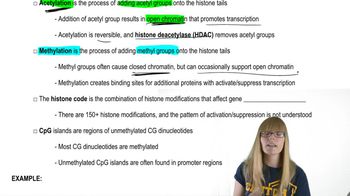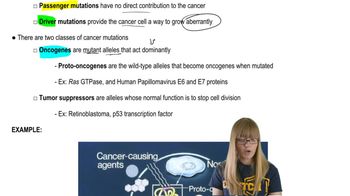Table of contents
- 1. Introduction to Genetics51m
- 2. Mendel's Laws of Inheritance3h 37m
- 3. Extensions to Mendelian Inheritance2h 41m
- 4. Genetic Mapping and Linkage2h 28m
- 5. Genetics of Bacteria and Viruses1h 21m
- 6. Chromosomal Variation1h 48m
- 7. DNA and Chromosome Structure56m
- 8. DNA Replication1h 10m
- 9. Mitosis and Meiosis1h 34m
- 10. Transcription1h 0m
- 11. Translation58m
- 12. Gene Regulation in Prokaryotes1h 19m
- 13. Gene Regulation in Eukaryotes44m
- 14. Genetic Control of Development44m
- 15. Genomes and Genomics1h 50m
- 16. Transposable Elements47m
- 17. Mutation, Repair, and Recombination1h 6m
- 18. Molecular Genetic Tools19m
- 19. Cancer Genetics29m
- 20. Quantitative Genetics1h 26m
- 21. Population Genetics50m
- 22. Evolutionary Genetics29m
19. Cancer Genetics
Cancer Mutations
Problem 19
Textbook Question
Cancer can be defined as an abnormal proliferation of cells that defy the normal regulatory controls observed by normal cells. Recently, histone deacetylation therapies have been attempted in the treatment of certain cancers [reviewed by Delcuve et al. (2009)]. Specifically, the FDA has approved histone deacetylation (HDAC) inhibitors for the treatment of cutaneous T-cell lymphoma. Explain why histone acetylation might be associated with cancer and what the rationale is for the use of HDAC inhibitors in the treatment of certain forms of cancer.
 Verified step by step guidance
Verified step by step guidance1
Understand the role of histones in gene expression: Histones are proteins that help package DNA into a compact, organized structure called chromatin. The acetylation of histones typically leads to a more relaxed chromatin structure, allowing for increased gene expression.
Explore the connection between histone acetylation and cancer: In cancer, certain genes that promote cell growth and division may become overexpressed due to increased histone acetylation, leading to uncontrolled cell proliferation.
Examine the function of histone deacetylases (HDACs): HDACs remove acetyl groups from histones, leading to a more condensed chromatin structure and reduced gene expression. This can help suppress the expression of oncogenes, which are genes that can cause cancer when overexpressed.
Consider the rationale for using HDAC inhibitors in cancer treatment: By inhibiting HDACs, HDAC inhibitors can increase acetylation levels, potentially reactivating tumor suppressor genes that have been silenced in cancer cells, thereby slowing down or stopping cancer progression.
Review the specific application of HDAC inhibitors: The FDA has approved HDAC inhibitors for treating cutaneous T-cell lymphoma, a type of cancer where these inhibitors can effectively alter gene expression to combat the disease.
Recommended similar problem, with video answer:
 Verified Solution
Verified SolutionThis video solution was recommended by our tutors as helpful for the problem above
Video duration:
2mPlay a video:
Was this helpful?
Key Concepts
Here are the essential concepts you must grasp in order to answer the question correctly.
Histone Acetylation
Histone acetylation is a post-translational modification where acetyl groups are added to the lysine residues on histone proteins. This modification reduces the positive charge on histones, leading to a more relaxed chromatin structure that promotes gene expression. In cancer, abnormal patterns of histone acetylation can result in the activation of oncogenes or the silencing of tumor suppressor genes, contributing to uncontrolled cell proliferation.
Recommended video:
Guided course

Histone Protein Modifications
Histone Deacetylases (HDACs)
Histone deacetylases (HDACs) are enzymes that remove acetyl groups from histones, leading to a more compact chromatin structure and reduced gene expression. Overactivity of HDACs can result in the repression of genes that normally inhibit cell growth and promote apoptosis, thereby facilitating cancer progression. Targeting HDACs with inhibitors can restore normal gene expression patterns and induce cancer cell death.
Recommended video:
Guided course

Histone Protein Modifications
HDAC Inhibitors in Cancer Therapy
HDAC inhibitors are a class of drugs that block the activity of histone deacetylases, leading to increased acetylation of histones and a more open chromatin structure. This can reactivate silenced tumor suppressor genes and enhance the expression of pro-apoptotic factors, making them effective in treating certain cancers, such as cutaneous T-cell lymphoma. The rationale for their use lies in their ability to reverse the epigenetic changes associated with cancer and restore normal cellular functions.
Recommended video:
Guided course

Cancer Characteristics

 4:50m
4:50mWatch next
Master Cancer Mutations with a bite sized video explanation from Kylia Goodner
Start learningRelated Videos
Related Practice


